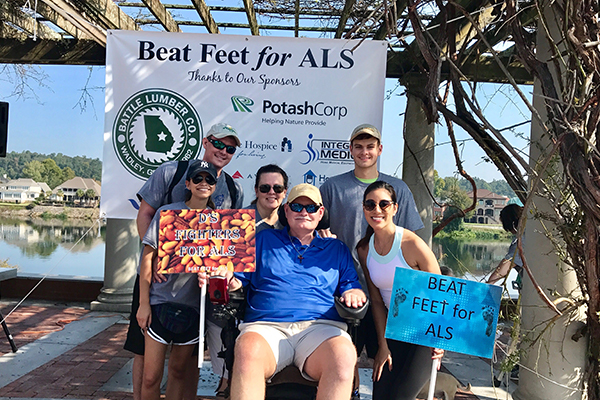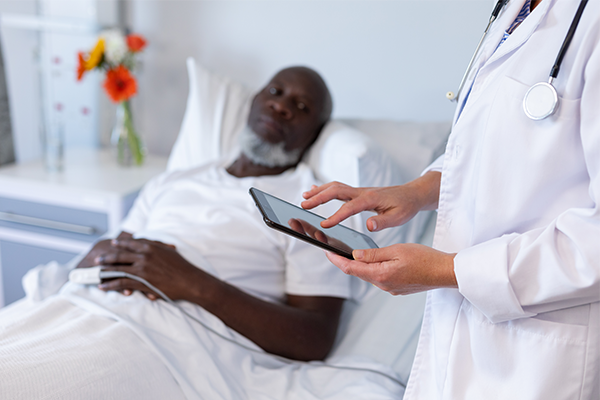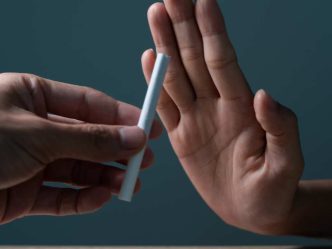“A big part of who you are is your voice,” said Stephanie Reyes, a speech-language pathologist at Augusta University Health. And when you can’t speak, it can feel impossible to work, be with your family in any meaningful way, or even do something as simple as order your favorite meal in a restaurant.
It’s surprising the many ways you can lose your ability to talk. About 2 million people in the U.S. have aphasia—a symptom of stroke where patients mix up words, like saying “apple” when they mean “hello.” Cancers of the head and neck can rob people of their tongues or vocal cords. Brain injury, multiple sclerosis and other neurological disorders like ALS—Lou Gehrig’s disease—also can harm the brain’s neurons that control speech.
But patients aren’t stuck with using pen and paper or sitting in silence. “Adaptive alternative communication” devices, or AAC, can help patients talk again—in a new way.
What Exactly is AAC?
“It’s a souped-up iPad, really,” said Reyes, pulling out an AAC inside her office at the Augusta University Health otolaryngology clinic. It’s sleek, flat and black—many even offer a handle or strap so patients can carry them as discreetly as a purse or messenger bag—while larger AACs are designed to fit onto wheelchairs.
They work at just a touch of a finger, or can be designed to react to an infrared dot fitted to a pair of glasses or just to simple eye movements.
At the most basic level, patients can type what they want to say, and the machine then will speak what they typed. But devices can also have multiple keyboards, and a second one could be preloaded with common phrases, like “I want…”or “Please help me…” For children, keyboards can even include pictures, such as a glass of water or a TV, so they can ask for those.
Devices can speak in either a male or female voice. But for patients who know that they will be losing their ability to speak—such as patients diagnosed with ALS or a mouth cancer where they will lose their tongue—it’s also possible to “bank” their voices. A patient will typically need to record a few thousand sentences, and devices then can be programmed to “speak” in his or her own voice.
Even if patients don’t have the time or energy to record that much, devices can bank special phrases, like “Hi, how are you?” or “I love you.” They can save commands to your pet, in your own voice. They can even bank bedtime stories, say if a grandparent anticipates or wants to continue that special time with a grandchild. It can also save those special words a patient may want to say to a child or grandchild at a graduation, wedding or other special event in the future.
Maximizing Your Voice
For any patient interested in a communication device, Reyes first sits down with the patient and family to come up with everything the patient might commonly say in a single day. “From wake to sleep,” she said. “Food requests, activities of daily living such as using the bathroom or needing to put on a sweater when it’s cold. This is to help us create specific buttons for specific phrases. We can also categorize phrases you would use with your grandchildren or when you go to the doctor’s office.”
Patients can also maximize the device’s many functions. Most can connect to social media or email, and many have Bluetooth options connected to a phone so patients can make calls. “Via this device, you can sync to a phone so you can have a real-time conversation,” said Reyes.
Not every patient is “techy.” Many may not even know how to use a keyboard at first, but they can learn. And the coolest thing about these devices is that the more a patient uses them, the more personalized they are. “Once you put a phrase in, you can set it to save,” said Reyes. “The longer you use it, the more it can do.”
And Reyes has seen herself how much of an impact it can make, from the child who was completely paralyzed being able to ask for mom and respond yes or no, to the man who was ecstatic about getting back his independence and being able to order his own beer at dinner.
“The whole point of therapy in general is to normalize,” said Reyes. “We want to get you back to your daily life, as close to normal as possible. At the same time, we know it’s not normal. For example, I broke my knee and I had all the rehab, but it’s not the same as it used to be. It’s the same thing with voice therapy. It’s what is the acceptable new normal.”





